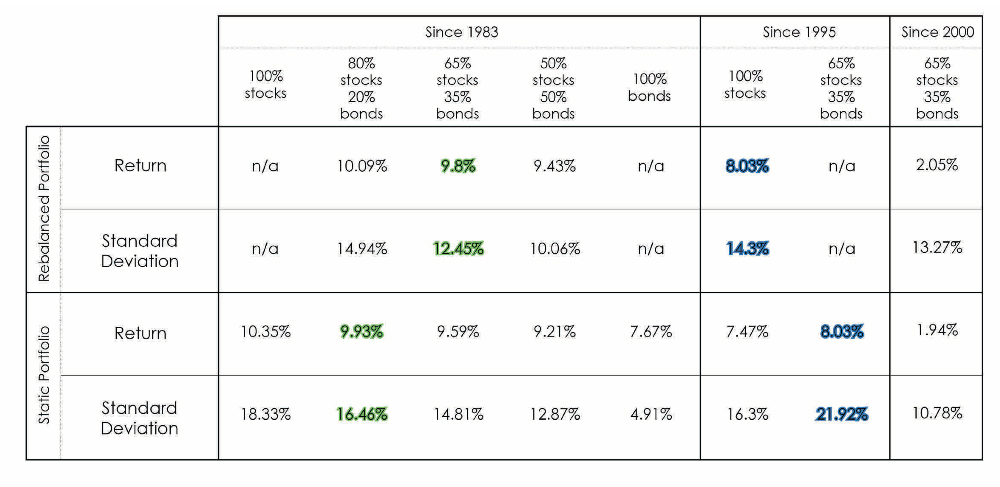A Balanced Portfolio — A Balanced Life
 We’ve all heard about the importance of asset allocation. But how can it really help you? What do those different allocations mean for risk? And do you really need to reallocate?
We’ve all heard about the importance of asset allocation. But how can it really help you? What do those different allocations mean for risk? And do you really need to reallocate?
This study demonstrates how splitting one’s assets between bonds and stocks in different ways affects the performance of a portfolio, while simultaneously showing the effect that rebalancing the portfolio has on returns and risk (volatility). The analysis constructs a $1,000,000 investment starting in 1983. Various portfolio strategies are then modeled, and the results shown as of December 31, 2009. As one might expect, the highest returns are achieved by allocating a higher percentage of funds into stocks, but the risks associated with such an allocation are much higher.
In this examination, a “rebalanced” portfolio is one where each year, the allocation of stocks to bonds is reset to the percentage that was determined at the outset. Rebalancing is accomplished by selling that asset class which has achieved an overweight position.
 For instance, say that a $1 million portfolio has been named a 50% stock/50% bond portfolio. At the end of the year, its stocks have grown in value to $600,000, while bonds grew to $550,000. To rebalance, we sell $25,000 of stock and buy $25,000 of bonds. Thus, we have $575,000 of both stocks and bonds at the beginning of the year. A “static” portfolio is one which does not rebalance: there is no shifting of funds between stocks and bonds after it is set up.
For instance, say that a $1 million portfolio has been named a 50% stock/50% bond portfolio. At the end of the year, its stocks have grown in value to $600,000, while bonds grew to $550,000. To rebalance, we sell $25,000 of stock and buy $25,000 of bonds. Thus, we have $575,000 of both stocks and bonds at the beginning of the year. A “static” portfolio is one which does not rebalance: there is no shifting of funds between stocks and bonds after it is set up.
“Standard deviation” is used to assess risk by measuring the amount by which returns can differ from the expected return.
For example, take a portfolio with an average return of 10% and a standard deviation of 5%. Such a portfolio would, by the definition of standard deviation, have a 68% likelihood of its year-end return falling within 5 percentage points of the average return, 10%. That is to say, there is a 2/3 chance that the return for a year will be between 5% and 15%. The lower the standard deviation, the more steady and reliable are the returns.
The time period used in this study is 26 years. The performance indexes used are the Barclays Capital Government/Credit Bond Index (BC GC BI) and the S&P 500.
[blockquote4]Once a bear market hits, the rebalancing strategy pays off.[/blockquote4]There are five levels of asset allocation in the model: 80% stocks/20% bonds, 65% stocks/35% bonds, 50% stocks/50% bonds, 100% bonds, and 100% stocks. For each of the three portfolios with a mix of stocks and bonds, we show two strategies — the first is a yearly rebalancing, while the second is “static,” with no rebalancing.
It’s no surprise that the 100% stock allocation outperforms the rest of the choices. However, a portfolio entirely invested in stocks has the highest vari- ability in its returns (standard deviation), 18.33%. On an annualized basis, stocks during this period returned 10.35%, slightly above the long-term average of 9.80%.
On the other end of the spectrum is the 100% bond portfolio. Very low in risk and very stable, it provides reasonable returns of 7.67% with a standard deviation of just 4.91%.
The 80% stocks/20% bonds portfolio performed better when rebalanced—the rebalanced port- folio ended with a value $500,000 greater than the static portfolio. In addition to higher returns, the annually rebalanced portfolio provided lower risk.
The value of the annually rebalanced 65/35 portfolio is $550,000 more than the 65/35 static portfolio. Remarkably, the 65/35 rebalanced portfolio ended the period with a value comparable to the static 80/20 portfolio’s. Thus, the 65/35 rebalanced port- folio attained very similar results to a riskier portfolio that did not rebalance (the 80/20 static portfolio).
If the study had been conducted before the 2008 decline in the stock market, the portfolios that were not rebalanced annually would have seen a better result. This is because of the extra weight given to equities by not rebalancing the portfolio during a bull market in stocks. Allowing the riskier asset class to build on itself during a bullish period results in significantly more losses when the market declines. Once a bear market hits, the rebalancing strategy pays off. “Buy and hold” is not a winning investment strategy.
The 50/50 portfolios had similar differences between them as above, but with lower returns and less risk. There is a difference in value because of a smaller weighting in stocks over a period that was generally positive for the stock market. This portfolio allocation assumed much less risk than the 65/35 portfolio, as can be seen in the significantly lower standard deviation of the overall portfolio returns.
From this set of data, it is easy to see the value of rebalancing to mitigate risk and improve return. On the chart, highlighted in green, we see that the 65/35 rebalanced port- folio approximated the 80/20 when not rebalanced. However, the rebalanced 65/35 portfolio had a much lower standard deviation: 12.5% vs. 16.5%, respectively. We see too, highlighted in blue, that in the series since 1995, the 65/35 rebalanced portfolio performed exactly as well as did the 100% stock portfolio. However, the rebalanced portfolio presented much less risk: 14.5% vs. 22%.
In fact, in every allocation category, rebalancing increased returns while simultaneously decreasing risk.
Also apparent is the importance of asset allocation in relation to an investor’s risk tolerance. An investor with no aversion to risk might choose the 100% stock portfolio for the best returns. However, the rise in gains is paid for with a 6% increase (nearly 50%) in standard deviation over the 65/35 rebalanced portfolio. An inves- tor seeking good returns with considerably reduced risk would be wise to choose a portfolio similar to the 65/35 or 80/20 rebalanced strategies showcased here, depending on his tolerance for risk.
Rebalancing one’s portfolio yearly can increase return and reduce risk. But rebalancing accomplishes a more important goal: enjoying a more balanced life.




